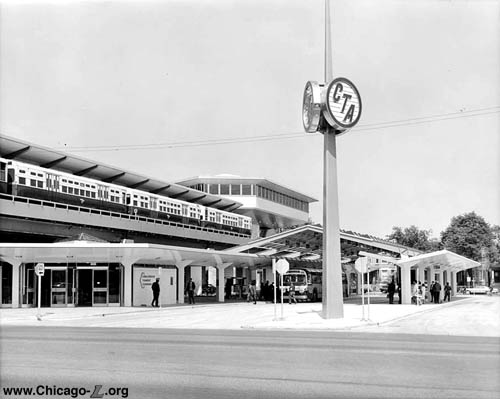
The Ashland
station, alternately known as the Englewood Transit
Terminal, opened in 1969 when Howard-Englewood "A" service
was extended 1/4 mile west from Loomis. In this view looking
northeast, a mixed North-South Route train of flat- and
curved-door 6000s is stopped on the elevated above, while
8700-series Flxible propane bus stops for surface riders in
the bus terminal. For a larger view, click here.
(Photo from CTA
Collection) |
Ashland/63rd
(1600W/6300S)
63rd Street and Ashland
Avenue, West Englewood
Service
Notes:
|
Green Line: Ashland Branch |

|
Accessible
Station |

|
Park'n'Ride: 235
spaces
|
Quick Facts:
Address: 6315 S. Ashland
Avenue
Established: May 6, 1969
Original Line: North-South Route, Englewood branch
Previous Names: Ashland
|
Skip-Stop Type:
|

|
Station
|
Rebuilt: n/a
Status: In Use
History:
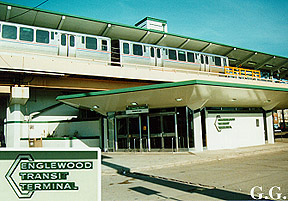
The Ashland station house is
seen looking north in 1998 with a Green Line train
above.
Inset: This sign,unique in the "L" system, adorns the
south exterior wall. (Photo by
Linda Garfield)
|
Despite the fact that the CTA did major upgrades to the Loomis Terminal
only a few years before, by the mid-1960s the
CTA decided to extend the
Englewood Line a few blocks west to a new terminal at Ashland Avenue.
By 1966, construction got underway on the $6,000,000 project,
financed by the City of Chicago and the U.S. Department of Housing
and Urban Development.
Though still in the design stage in 1967, construction proceeded
quickly and in 1968, a new car shop was built near the Racine
station to replace the meager facilities at Loomis.
The Loomis Yard was extended west to a point just east of the Ashland
station. Yard capacity was increased from 136 to 200 cars. The tracks
actually were extended a few blocks west of Ashland to Hermitage
Avenue to allow trains to turn ends without blocking the platform.
The new terminal facility opened in 1969.
Designed by the Bureau of Architecture of the Department of Public
Works of the City of Chicago, Ashland is very typical of structures
built around suburbia in the 1950s and 1960s. While the cantilevers,
hipped roofs and broad eaves are inspired by Frank Lloyd Wright, the
absence of ornamental features shows the influence of the
Bauhaus.
The station was designed with a single island platform and a
street-level station house on the east side of Ashland Avenue. The
platform was covered by a flat angled canopy that ran nearly its
entire length. An auxiliary exit at the west end of the platform
provided access to the west side of Ashland Avenue and southbound
buses on Ashland. The primary station house was largely located
underneath the elevated structure, although its south end projected out
from under the structure, providing one of the facility's signature
features with its broad, angled, cantilevered eaves. Inside, the
station had an open and spacious interior with white-tiled walls. Two
entrances provided access, one angled southwest facing Ashland Avenue
and the other southeast facing the bus terminal. Inside, between
these two doorways on the south wall, was a built-in newsstand. The
fare array divided the station interior just north of the doors, with
three specially-designed, angular ticket agent's booths: one
freestanding island-type booth, and two more integrated into the
walls at each end of the fare controls. Beyond the turnstiles was a
spacious paid area, with two sets of stairs and treadle-controlled
escalators. In the northwest corner of the paid area were two
rotogate auxiliary exits, providing egress to the northwest corner of
the station site nearer to the corner of Ashland and 63rd.
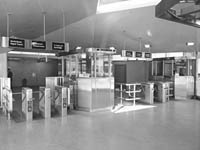
The open and airy interior
of the Ashland/63rd station, seen looking north in the
unpaid area shortly after opening in 1969. Note the rather
1960s-looking agents' booths, fare control barriers, and
hanging backlit signs. The freestanding island agent's booth
has since been removed, as have the turnstiles and signs.
For a larger view, click here.
(Photo from the CTA Collection)
|
The Ashland Terminal was designed to be intermodal, an
acknowledgment of the post-World War II reality that transit would
not win its market share going it alone. An off-street bus terminal
was integrated into the facility, with a long, peaked roof with a
skylight over the road to allow in natural light. Initially, five bus
routes (the #9 Ashland, #45 Ashland-Downtown, #49A South Western, #63
63rd Local and Express, and #110 Marquette) served this terminal.
Today, only two (the #9 and #63) do. In a nod to the auto-dominance
of the era (and indeed, still of today), a park'n'ride lot was built
as part of the complex, located to the south at 64th and Ashland,
that could accommodate 250 automobiles. Today the lot accommodates
slightly fewer cars, with a capacity of 235 autos. Also, a
kiss'n'ride drop off lane was built to the south of the bus terminal
lanes, on the north edge of the park'n'ride.
Perhaps the station's most recognizable element is a tall
decorative spire located in the bus terminal, south of the station
entrance along 63rd Street. The tall marker has a triangular pylon
that ends in a point with a three-sided backlit marker on the top
consisting of a CTA logo on
each of the street sides.
The project also included the construction of a new transportation
office above the Ashland platform. Located at the east end of the
platform, this building, with its angled roofline and windows all the
way around held up far above the station canopy, is often easily
mistaken for a control tower. In fact, this Transportation Office is
a headquarters for operating personnel and line supervision. Inside
are a breakroom, restrooms, lockers, clerks, and offices for the
South Section of the North-South Route (today, for the South Elevated
section of the Green Line). Upon the station opening, the South
Section's administrative headquarters and superintendent's office
relocated here from 61st Street Yard, although a part-time office was
opened at 61st and used for several decades.
Green Line Renovation
On February 21, 1993, the South Side Englewood-Jackson Park service,
formerly paired with the Howard service and forming the North-South
Route, was repaired with the Lake Street service and formed the
CTA's new Green Line.
On January 9, 1994, the Green Line closed for a two-year
rehabilitation. All stations on the line, including Ashland/63rd, closed for
renovation. In 1991, the
CTA identified Ashland/63rd as one of
35 stations to be upgraded to be handicap accessible (and one of 21
to be finished by 1996). So, an elevator was added in the Green Line renovation project, making the station ADA accessible. When the
new, modern Cubic TransitCard turnstiles were installed, the center
island ticket agent's booth was removed. The side booths remain, the
west one used by the Customer Assistant and the east one generally
unused. The station sports a green and white color scheme, denoting
the terminal's place on the Green Line.
The North-South Route (Temporarily) Returns, Thrice
In 2013, the CTA launched the Red Line South Reconstruction Project, a track renewal project to rebuild the Dan Ryan branch tracks from the bottom up, excavating down to the bottom of the trackbed to rebuild the underground drainage system then installing new ballast, ties, and tracks. Some modest station improvements were also performed. In order to perform the work more quickly and cost-effectively, the CTA closed the Dan Ryan branch for five months while work was performed. During that time, there would be no 'L' service on the Dan Ryan branch south of Roosevelt station.
As part of the alternate service plan for Dan Ryan riders, Red Line trains were rerouted via the old 13th Street Incline from the State Street Subway to the South Side Elevated, where they operated to Ashland/63rd via the South Side Elevated tracks in a pattern reminiscent of the old Howard-Englewood "A" trains of the North-South Route days.
Red Line service to Ashland/63rd began on Sunday, May 19, 2013. Following the five-month track reconstruction and renovation work on the Dan Ryan, Red Line service to 95th resumed at 4am, Sunday, October 20, 2013. At the same time, Red Line service via the South Side Elevated and Englewood branch was annulled and Green Line trains resumed service to Ashland/63rd, alternating between the two 63rd Street terminal branches.
Red Line service between Howard and Ashland/63rd via the South Side Elevated returned temporarily in 2017, although it was only select trains and only during weekday rush periods; during most times, normal service via the Dan Ryan branch continued. The diversion was necessitated by the $280 million 95th Terminal Improvement Project to expand and greatly improve the 95th/Dan Ryan Red Line station -- as construction continued on the new terminal, including foundations and structural steel work next to the tracks, track alignment work, and platform construction, CTA needed to close both the east and west platform tracks (at separate times), severely constraining capacity during rush and requiring a reduction in the number of trains in and out of the station.
On April 3, 2017, CTA began rerouting some Red Line trains, primarily in the off-peak direction, for a few hours each weekday onto the Green Line to or from the Ashland/63rd station. Reroutes onto the south Green Line in the off-peak direction took place in the morning (7:56 to 9:14am) and evening (4:40 to 5:58pm) rush periods (times at Roosevelt, just north of the diversion point); there were also a small number of trains that operated between Ashland/63rd and Howard in the peak direction, though primarily for car-balancing purposes. CTA officials said the reroute affected less than 10 percent of all Red Line trains.
The diversion of select rush period Red Line trains to/from Ashland/63rd lasted for approximately six months, with the last Howard-Ashland/63rd trains running Wednesday evening, November 22, 2017.
The Red Line Ashland/63rd service resumed on July 30, 2018, to allow additional work in, over and around the platform tracks at 95th/Dan Ryan; the last day of this iteration of the service last ran on April 26, 2019.
.
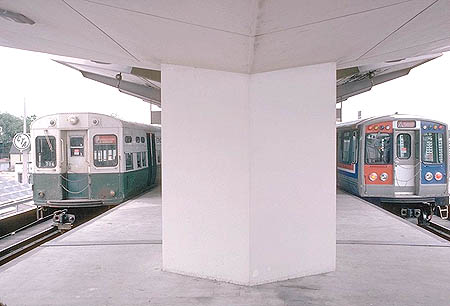
Two Englewood-Howard "A"
trains -- one led by car 2457 on the right, one of
6000s
on the left -- await departure times at the Englewood
terminal at Ashland/63rd on August 17, 1978. For a larger
view, click here.
(Photo by Doug Grotjahn, Collection of Joe
Testagrose)
|

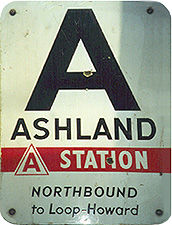
|
ashland-63rdSign.jpg (30k)
Ashland station sign, circa 1969. (Sign from
the collection of Graham Garfield) |

|
ashland-63rd01.jpg
(33k)
Ashland Terminal, looking northwest in 1985. The
cantilevered trainroom looms above the rest of the station
facility. The park'n'ride is on the left.
(Photo by Olga Stefanos)
|
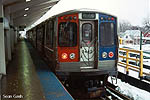
|
cta2442b.jpg (74k)
After changing ends, car 2442 brings up the rear of a Green
Line train loading passengers at Ashland/63rd before heading
to the Loop and Oak Park on Saturday December 16,
2000. (Photo by Sean Gash) |
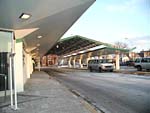
|
ashland-63rd04.jpg
(136k)
The Ashland terminal was specifically built as an intermodal
facility, with both a park'n'ride and a bus terminal seen
here looking east in 2001. When it opened in 1969, the
Ashland station was served by the CTA's #9 Ashland, #45
Ashland-Downtown, #49A South Western, #63 63rd, and #110
Marquette route, as well as the South Suburban Safeway
Lines' #501 route. Today it is served only by the #9 and
#63. (Photo by Mary Kramer, CTA)
|
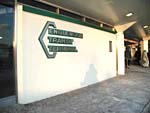
|
ashland-63rd05.jpg
(102k)
Although it is almost never referred to by this name today
(if it ever was), "Englewood Transit Terminal" is emblazoned
on the south elevation of the station house, facing the bus
terminal. (Photo by Mary Kramer,
CTA)
|

|
IRMtrip@Ashland1.jpg (56k)
Ashland Terminal in the 1980s? Nope. 6000-series car 6655 is at the Englewood terminal on May 6, 2001 for the IRM PCC car fantrip, though
it bears the destination sign of the Englewood-Howard "A"
run that the 6000s would have run in that era. (Photo by Graham Garfield) |
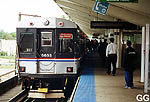
|
IRMtrip@Ashland2.jpg (52k)
A wider shot of the IRM car
6655 at Ashland/63rd on May 6, 2001, showing the surrounding
island platform. (Photo by Graham
Garfield) |
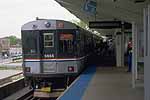
|
cta6655c.jpg
While on the IRM's
PCC fan trip, car 6655 is at the end of the Englewood Branch
at Ashland terminal on May 6, 2001. The rear of the train --
indicated by the red rear-end markers -- bears the
destination sign of the station's old route, the
Englewood-Howard "A" line. (Photo by Mike
Farrell) |
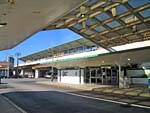
|
ashland-63rd06.jpg
(150k)
The Ashland/63rd station is seen looking northwest from
under the bus terminal shed on October 17, 2004. The east
entrance to the station house from the bus bay is seen in
the lower right. (Photo by Tony
Coppoletta)
|
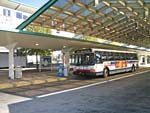
|
ashland-63rd07.jpg
(170k)
Looking northeast on October 17, 2004, 1995-vintage Flxible bus 6242
is stopped at the Ashland/63rd station's bus terminal while
operating on the westbound #63 63rd route. The skylights in
the peaked canopy over the bus bay provide natural light
into the boarding area. The Green Line is visible above in
the upper left, and the entrance to the "L" station from the
bus terminal is just out of frame on the
left. (Photo by Tony Coppoletta)
|
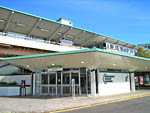
|
ashland-63rd08.jpg
(138k)
The Ashland/63rd station's broad, angled, cantilevered eaves
shows the influence of the later modernist work of Frank
Lloyd Wright, as well as the streamlining of the Bauhaus, in
its 1960s suburbia-typical architecture, seen in this view
of the station house and elevated platform canopy above
looking northeast on October 17, 2004.
(Photo by Tony Coppoletta)
|
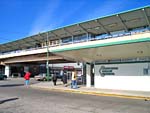
|
ashland-63rd09.jpg
(140k)
Looking northwest from the bus terminal driveway, the
Ashland/63rd station house is seen on the right, the
elevated boarding platform and canopy above, and the
auxiliary exit on the west side of Ashland Avenue on the far
left on October 17, 2004. Note the distinctive and
one-of-a-kind Englewood Transit Terminal emblem on the
station house's south elevation. (Photo by
Tony Coppoletta)
|
|

|

|


















